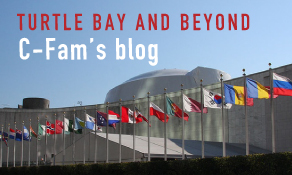UN-safe Abortion: How the Abortion Industry has Used UN Agencies to Legitimize Abortion
Introduction
The often-repeated adage that abortion should be “safe, legal, and rare,” popularized by U.S. President Bill Clinton, generally captures how the term “safe abortion” was once understood. Abortion is not a good thing. It should be avoided as much as possible. Since the Clinton era, though, abortion advocates have distanced themselves from the phrase, arguing that the word “rare” imparts stigma. Instead, they have increasingly worked to frame abortion as a good thing, and used the word “safe” as part of the push to establish abortion as an international right.
“Unsafe abortion” and “safe abortion” are terms used by international agencies and the abortion industry lobby to pressure countries into changing their laws to make abortion legal. The assumption behind this use of the terms is that governments must do everything in their power to prevent women from seeking abortions in unsafe conditions, or what have been commonly called “back-alley abortions.” They then translate this into pressure on governments to make abortion legal, in order for it to be made safe.
This Definitions describes the genesis of the term in UN documents and how their use of it has changed in recent years to promote abortion.
UN Consensus on “Unsafe abortion”
The consensus of the 1994 International Conference on Population and Development (ICPD) was against the international system promoting abortion, inasmuch as it rejected the notion of abortion as a human right. That was the only time in UN negotiations that abortion was addressed in UN policy. Previous negotiations simply left it out of agreements altogether as a matter for domestic legislation. At the 1994 Cairo conference, UN member states agreed however on a range of policies related to “unsafe abortion.”
The conference urged governments and UN agencies “to deal with the health impact of unsafe abortion as a major public health concern and to reduce the recourse to abortion through expanded and improved family-planning services.” It also set as an objective “to reduce greatly the number of deaths and morbidity from unsafe abortion,” and committed governments to carry out research on “unsafe abortion.”
The ICPD conference also agreed that “In circumstances where abortion is not against the law, such abortion should be safe.”
These caveats, found in paragraph 8.25 of the ICPD conference outcome document, presume that abortion is illegal in many or all circumstances and that abortion carries inherent risks for mothers. Paragraph 8.25 also insists that abortion is an issue that is exclusively to be left to national legislation, and therefore not an international right or something the UN system should be involved in promoting.
The caveats in Paragraph 8.25 also include that “every attempt should be made to eliminate the need for abortion” and that “women should have access to quality services for the management of complications arising from abortion. Post-abortion counselling, education and family-planning services should be offered promptly, which will also help to avoid repeat abortions.”
A footnote in the conference outcome linked to the definition of “unsafe abortion” for public health purposes by the World Health Organization.
Unsafe abortion is defined as a procedure for terminating an unwanted pregnancy either by persons lacking the necessary skills or in an environment lacking the minimal medical standards or both (based on World Health Organization, The Prevention and Management of Unsafe Abortion, Report of a Technical Working Group, Geneva, April 1992 (WHO/MSM/92.5))
Were it not for these caveats, it is unlikely that “sexual and reproductive health,” “reproductive rights,” and abortion in particular would have been included in the ICPD agreement in the first place.
Unsafe or Illegal?
In the 1970s and 1980s, feminist organizations campaigned against “illegal” abortion by calling for legal abortion. The shift to language about “safety” was a strategic move described by former International Women’s Health Coalition (IWHC) president Adrienne Germain:
Most advocates referred to abortion as “illegal,” believing that eliminating legal restrictions was necessary for expanding access. Knowing that legal change would take many years during which thousands of women would die or be severely injured by unsafe abortion, IWHC promoted safe abortion services for all women who are “eligible under existing laws.” Almost all national laws allow abortion to save the life of the woman and on one or more additional grounds (e.g., health, rape, incest, severe fetal anomalies). Using this perspective, IWHC asserted that all but four or five countries are obligated to train and equip health care workers to provide safe services.
According to Germain, IWHC lobbied the WHO to issue technical and policy guidance on “safe abortion” based on the logic that abortion training needed to be provided in nearly all countries, at least for rare cases.
Abortion advocates have asserted that abortion is more likely to be “unsafe” where it is also illegal and performed under clandestine circumstances. Nevertheless, the WHO’s 1992 definition of an “unsafe abortion” is more slippery than it initially appeared. In 2014, WHO issued a clarification which states:
Nothing in the definition predetermines who should be considered a “safe” abortion provider or what the appropriate skills or standards for performing abortions should be. Such things are not static; they evolve in line with evidence-based WHO recommendations.
This clarification was published in response to the dramatic shift from surgical to medical abortion, which led to the WHO considering lower-level medical workers, and even patients themselves, as “safe” providers. Therefore, WHO asserts that “illegal abortion is not synonymous with unsafe abortion” as “the legal context and the level of safety are closely intertwined, but the association is context-specific.”
Safe Abortion “to the Full Extent of the Law”
Since 1994, UN agencies and the UN secretariat have turned the caveats in the ICPD agreement on their heads. They now treat the commitments in the ICPD to prevent and address complications arising from “unsafe abortion” as a mandate to promote abortion as a human right in their technical guidance and lobbying activities.
In 2018, UN Women produced a UN systemwide manual on Access to Justice that instructs UN staff working to reform legal systems to lobby countries to “decriminalize” abortion, and repeatedly cites UN treaty monitoring bodies’ nonbinding opinions that states must “ensure that sexual and reproductive health care” includes “safe abortion services” to achieve the Sustainable Development Goals. Consistent with that manual, UN agencies in Mexico, including the Office of the High Commissioner for Human Rights (OHCHR), UN Women, the United Nations Population Fund (UNFPA), and the United Nations Office on Drugs and Crime (UNODC) interfered in litigation on the subject of abortion in the State of Veracruz, arguing that women have a right to “quality” abortion services.
Since the WHO issued its 2012 technical guidance on “Safe Abortion,” the international health agency has also promoted the notion of “abortion to the full extent of the law.”
Far from respecting the caveats in the ICPD agreement by carving out space for national laws, the notion of safe abortion “to the full extent of the law” is designed to limit the ability of governments to regulate abortion and to force medical providers to refer for abortions against their conscience.
The WHO technical guidance challenges basic legal restrictions on abortion, such as limitations on abortion based on the gestational age of an unborn baby medical authorization requirements, and requirements for consent from a parents or spouses. They are challenged as “legal, regulatory, and access barriers” that should be “eliminated” as a human rights matter.
The WHO technical guidance explicitly states that health care providers who exercise their conscience rights and refuse to perform or participate in an abortion, still “must refer the woman to a willing and trained provider in the same, or another easily accessible health-care facility.”
This same notion of “safe abortion to the full extent of the law” is repeated in the UN’s Inter-Agency Field Manual on Reproductive Health in Humanitarian Settings, where conscience rights are also undermined. It was likewise promoted by the UN population fund at the 2019 Nairobi Summit:
Policy-makers and health-care managers working to provide reproductive health services should always ensure that safe abortion care is readily accessible and available to the full extent of the law.
The notion of “safe abortion” is not scientifically accurate
Abortion always involves the death of at least one human being. As such, it should never be labeled “safe.” Moreover, any surgical procedure may result in complications, including bleeding and infections. Absent intervening factors, medical abortions inevitably expose women to risks to which they would not otherwise be exposed if they were to carry a pregnancy to term. Women in developing countries are exposed to exponentially higher risk from both medical and surgical abortions because of lack of access to health care, antibiotics, transfusions, etc.
One study in Finland found that one out of twenty women who underwent so-called “safe” surgical abortion and 25% of women undergoing “safe” medical abortion had complications including hemorrhage, incomplete abortion and need for repeat surgery. In the United States, the Food and Drug Administration (FDA) documented 605 reports of complications from medical abortions in the first 3 years of the use of mifepristone in medical abortions, one third of which involved severe bleeding and emergency surgery.
Medical studies increasingly document how induced abortion exposes women and their children to higher risks from pre-term birth, which is the leading cause of perinatal death Numerous studies demonstrate that women undergoing “safe” abortion have a significantly increased risk of subsequent suicide, major depression and substance abuse.
In the context of public health, it is also not accurate to tie the notion of “unsafe abortion” to the status of abortion in the law. Since the Millennium Development Goals began to focus the attention of the international health community on maternal health, abortion groups have diligently made abortion laws a component of maternal health policy, arguing that 13% of all maternal deaths are related to abortion. A more recent study published in The Lancet put the figure closer to 8%. Nevertheless, estimates of abortion incidence, and of abortion-related maternal mortality, remain contentious subjects. One reason is the difficulty in distinguishing between induced and spontaneous abortions (miscarriages) in settings where women may be reluctant to accurately report the circumstances due to cultural stigma or fear of legal repercussions.
Another issue is that, among the leading causes of maternal mortality such as infection or hemorrhage, “unsafe abortion” is unlike the others inasmuch as an induced abortion is not a naturally-occurring complication of pregnancy or childbirth. While the consensus at ICPD urged countries to provide women with alternatives to abortion, the discourse around reducing deaths due to “unsafe abortion” often omit discouraging women from seeking abortions as a potential life-saving measure. Rather, they adopt a fatalistic view that a woman seeking abortion will inevitably obtain one, and the only remaining question is whether she will have the option to do so legally and “safely.”
As we have demonstrated before, “there is no clear association between making abortion legal or more widely accessible and a reduction in the proportion of maternal mortality due to abortion.” There simply is no evidence that making abortion legal and more widely accessible is a significant measure to improving maternal health. There is not a lower relative percentage of maternal mortality attributable to abortion in countries with more liberal abortion laws.
CONCLUSION
While the notion of promoting “safe abortion to the full extent of the law” has been inserted often in UN agency policies, it has yet to replace the ICPD consensus on abortion. That agreement framed abortion as a last resort from which women must be protected. UN member States have not yet endorsed the notion of “safe abortion to the full extent of the law” in UN resolutions the same way UN agencies have endorsed it.
If governments were to follow the lead of UN agencies and accept the notion of “safe abortion to the full extent of the law” in UN agreements, it would run counter to and contradict all of the caveats against abortion in the ICPD framework. That, in turn, would erode the presumption of the right to life for the unborn child in international law. Governments must not follow UN agencies on this issue. Nations must renew their pledge to help women avoid the dangers and harms of abortion by rejecting the spurious notion of “safe abortion.” They can thereby reject the dangers of making abortion a staple of UN programming. Governments, not UN staff, must lead the way.
See PDF for full citations.
View online at: https://c-fam.org/definitions/un-safe-abortion-how-the-abortion-industry-has-used-un-agencies-to-legitimize-abortion/
© 2026 C-Fam (Center for Family & Human Rights).
Permission granted for unlimited use. Credit required.
www.c-fam.org









